Abstract
A descriptive epidemiologic study was conducted to quantitate the occurrence of zoonoses in pet animals (almost exclusively dogs and cats) at 30 Air Force bases in nine regions of the United States during 1980 and 1981. Reviews of reported cases of pet-associated zoonoses in humans at these bases were included. Occurrence of a zoonotic disease in dogs and cats was expressed as a ratio of reported cases per 100 rabies vaccinations (cs/Crv). Overall, the four zoonoses reported most frequently from these pets were hookworms, roundworms, tapeworms, and fleas. Annual ratios revealed geographic variations: for example, hookworms in dogs and cats in the southeast ranged from 12.3 to 9.4 cs/Crv; in the northern Great Plains, hookworms ranged from 0.9 to 0.4 cs/Crv. Dermatomycoses in the southeast ranged from 1.3 to 1.1 cs/Crv, and in Alaska from 0.3 to 0.2 cs/Crv. Quarterly zoonoses occurrence revealed seasonal variations in several regions. Reports of zoonoses in people from these bases indicated that five less frequent zoonoses in dogs and cats (Microsporum canis dermatomycosis, fleas, Sarcoptes scabiei var canis, Gram-positive bacterial infections, and rabies) presented greater acute threats to humans than did the four most frequent zoonoses reported from their pets.
Full text
PDF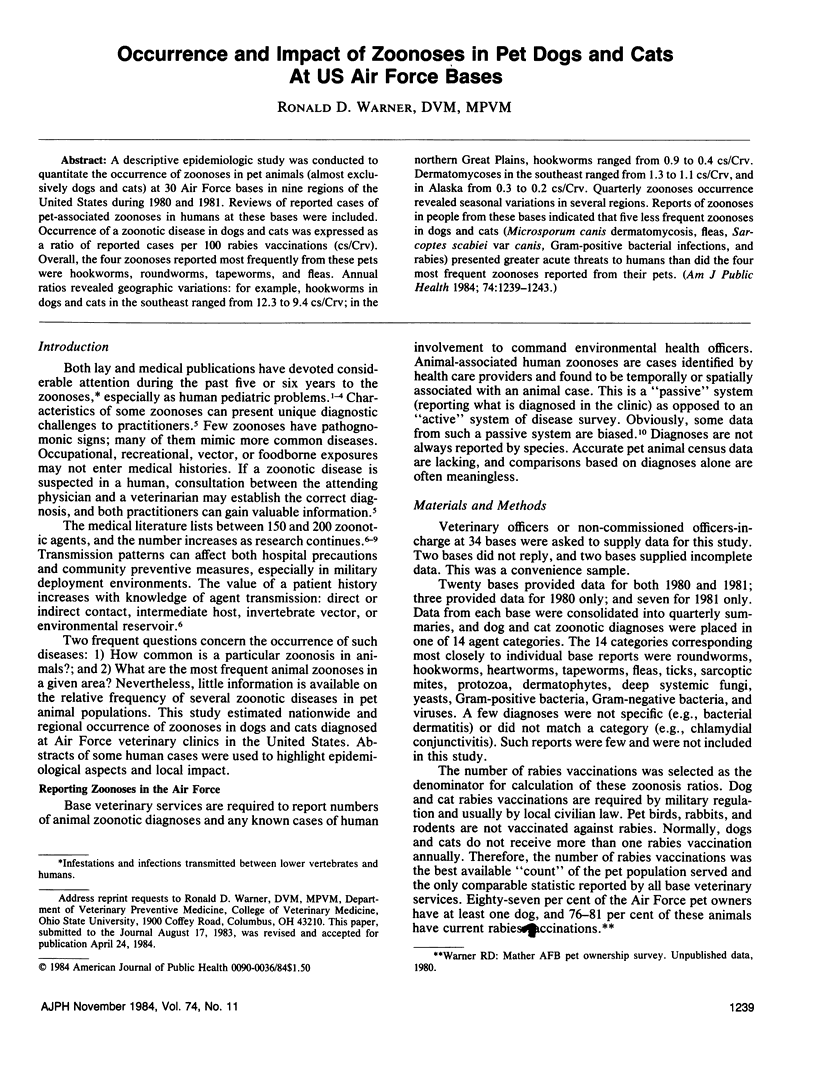
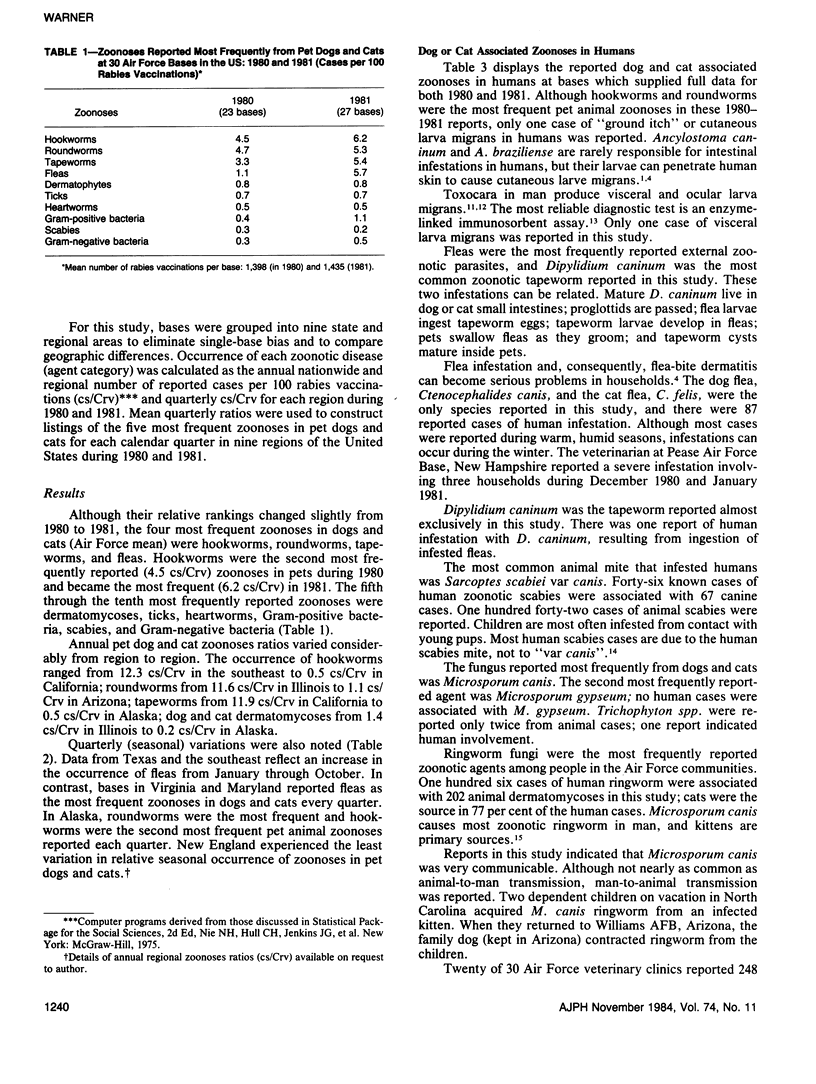
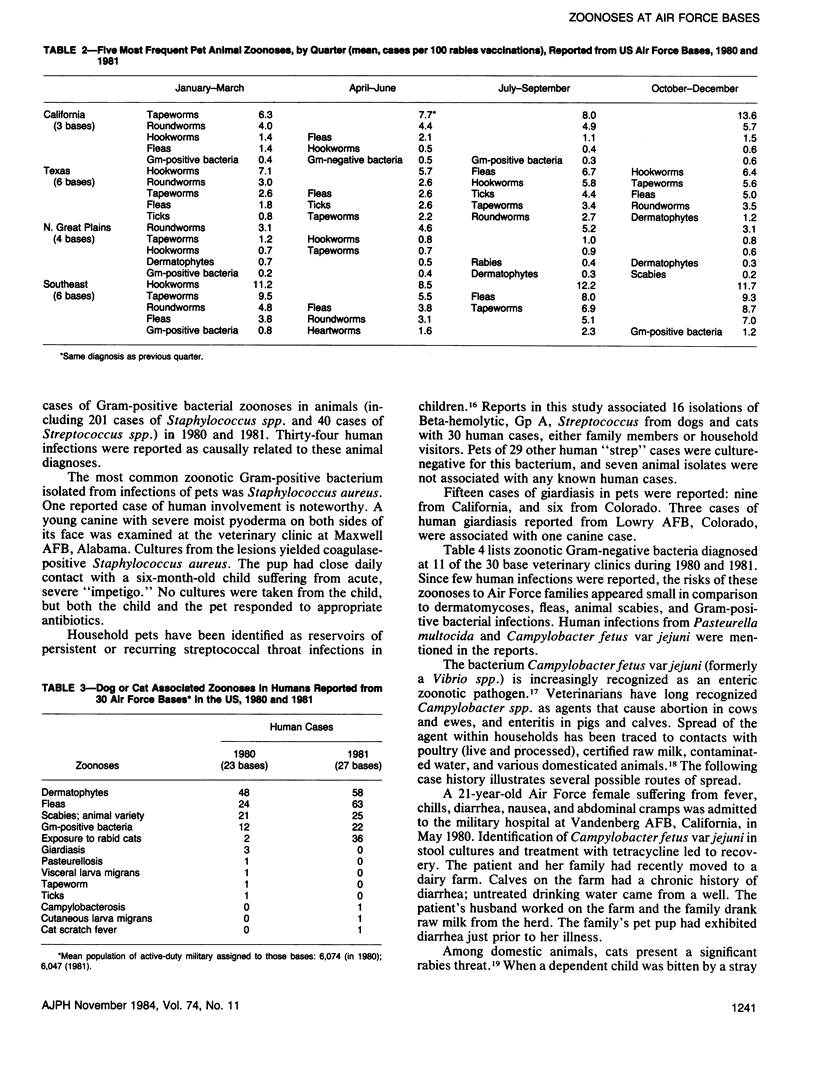
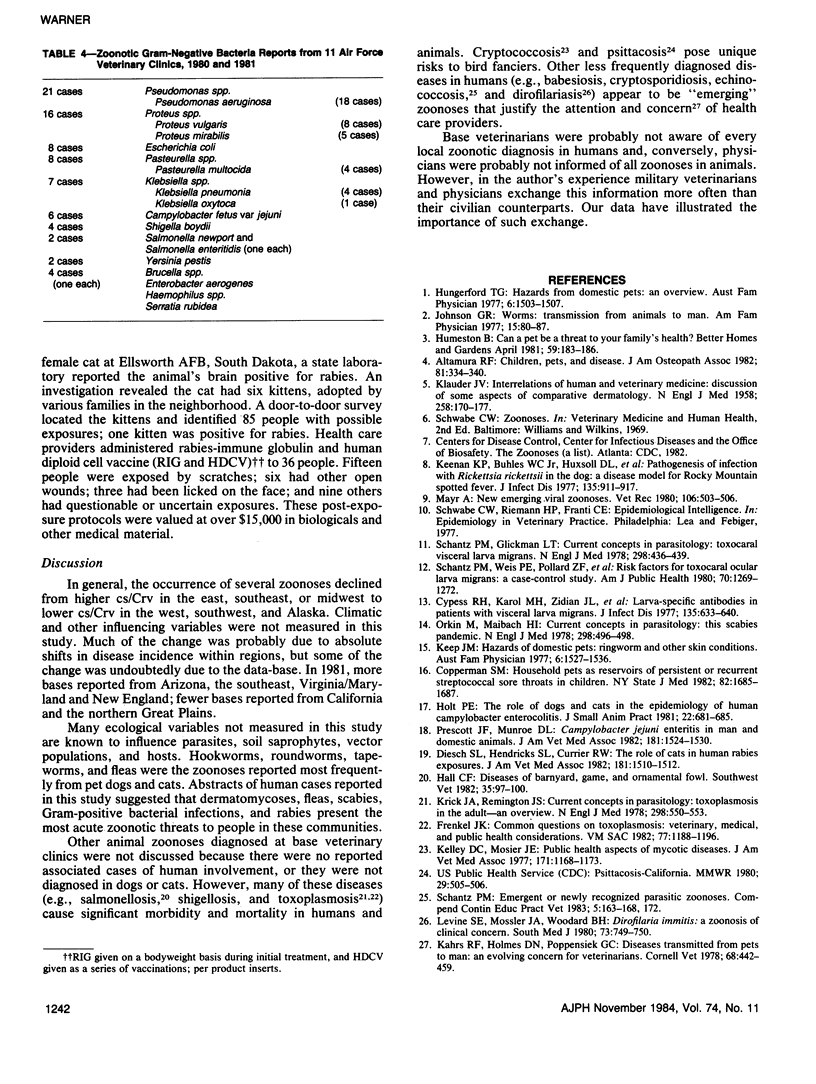
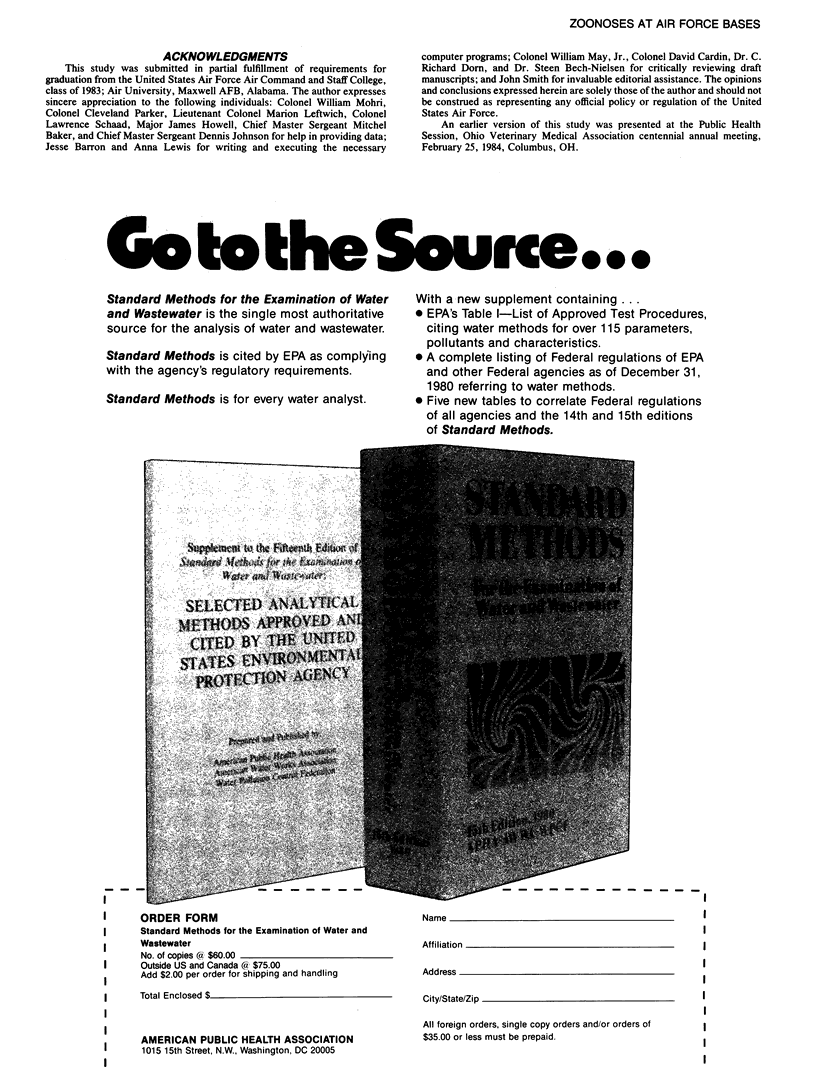
Selected References
These references are in PubMed. This may not be the complete list of references from this article.
- Altamura R. F. Children, pets, and disease. J Am Osteopath Assoc. 1982 Jan;81(5):334–340. [PubMed] [Google Scholar]
- Copperman S. M. Cherchez le chien: household pets as reservoirs of persistent or recurrent streptococcal sore throats in children. N Y State J Med. 1982 Nov;82(12):1685–1687. [PubMed] [Google Scholar]
- Cypess R. H., Karol M. H., Zidian J. L., Glickman L. T., Gitlin D. Larva-specific antibodies in patients with visceral larva migrans. J Infect Dis. 1977 Apr;135(4):633–640. doi: 10.1093/infdis/135.4.633. [DOI] [PubMed] [Google Scholar]
- Diesch S. L., Hendricks S. L., Currier R. W. The role of cats in human rabies exposures. J Am Vet Med Assoc. 1982 Dec 15;181(12):1510–1512. [PubMed] [Google Scholar]
- Holt P. E. The rôle of dogs and cats in the epidemiology of human campylobacter enterocolitis. J Small Anim Pract. 1981 Oct;22(10):681–685. doi: 10.1111/j.1748-5827.1981.tb00572.x. [DOI] [PubMed] [Google Scholar]
- Hungerford T. G. Hazards from domestic pets. An overview. Aust Fam Physician. 1977 Dec;6(12):1503–1507. [PubMed] [Google Scholar]
- Johnson G. R. Worms: transmission from animals to man. Am Fam Physician. 1977 May;15(5):80–87. [PubMed] [Google Scholar]
- KLAUDER J. V. Interrelations of human and veterinary medicine; discussion of some aspects of comparative dermatology. N Engl J Med. 1958 Jan 23;258(4):170–177. doi: 10.1056/NEJM195801232580405. [DOI] [PubMed] [Google Scholar]
- Kahrs R. F., Holmes D. N., Poppensiek G. C. Diseases transmitted from pets to man: an evolving concern for veterinarians. Cornell Vet. 1978 Oct;68(4):442–459. [PubMed] [Google Scholar]
- Keenan K. P., Buhles W. C., Jr, Huxsoll D. L., Williams R. G., Hildebrandt P. K., Campbell J. M., Stephenson E. H. Pathogenesis of infection with Rickettsia rickettsii in the dog: a disease model for Rocky Mountain spotted fever. J Infect Dis. 1977 Jun;135(6):911–917. doi: 10.1093/infdis/135.6.911. [DOI] [PubMed] [Google Scholar]
- Keep J. M. Hazards of domestic pets. Ringworm and other skin conditions. Aust Fam Physician. 1977 Dec;6(12):1527–1536. [PubMed] [Google Scholar]
- Kelley D. C., Mosier J. E. Public health aspects of mycotic diseases. J Am Vet Med Assoc. 1977 Dec 1;171(11):1168–1170. [PubMed] [Google Scholar]
- Krick J. A., Remington J. S. Toxoplasmosis in the adult--an overview. N Engl J Med. 1978 Mar 9;298(10):550–553. doi: 10.1056/NEJM197803092981006. [DOI] [PubMed] [Google Scholar]
- Levine S. E., Mossler J. A., Woodard B. H. Dirofilaria immitis: a zoonosis of clinical concern. South Med J. 1980 Jun;73(6):749–750. [PubMed] [Google Scholar]
- Mayr A. New emerging viral zoonoses. Vet Rec. 1980 Jun 14;106(24):503–506. doi: 10.1136/vr.106.24.503. [DOI] [PubMed] [Google Scholar]
- Orkin M., Maibach H. I. Current concepts in parasitology. This scabies pandemic. N Engl J Med. 1978 Mar 2;298(9):496–498. doi: 10.1056/NEJM197803022980906. [DOI] [PubMed] [Google Scholar]
- Prescott J. F., Munroe D. L. Campylobacter jejuni enteritis in man and domestic animals. J Am Vet Med Assoc. 1982 Dec 15;181(12):1524–1530. [PubMed] [Google Scholar]
- Schantz P. M., Glickman L. T. Toxocaral visceral larva migrans. N Engl J Med. 1978 Feb 23;298(8):436–439. doi: 10.1056/NEJM197802232980806. [DOI] [PubMed] [Google Scholar]
- Schantz P. M., Weis P. E., Pollard Z. F., White M. C. Risk factors for toxocaral ocular larva migrans: a case-control study. Am J Public Health. 1980 Dec;70(12):1269–1272. doi: 10.2105/ajph.70.12.1269. [DOI] [PMC free article] [PubMed] [Google Scholar]


